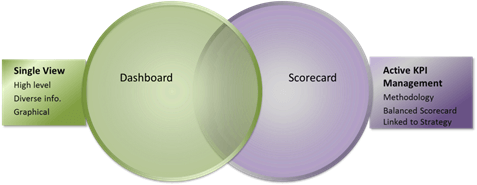These terms are often used interchangeably, which can cause confusion. There is no rule about what each term means, but I like to make a distinction between the two to remove that confusion. The following diagram summarises what I see as the essential differences between the two:

Dashboards
Dashboards typically attempt to provide management with high level information about different parts of the business, in one view. This view may be:
- One IBM Cognos Report Studio report, with multiple objects displayed
- An IBM Cognos dashboard with dynamic content – Report Studio objects, conditional formatting, drilling through to more detailed reports
Scorecards
typically provide management with metrics that they need to actively manage because they are important to the business. They assist management by:
- Showing what parts of the business drive the KPIs
- Show the progress over time and make a prediction about what will happen if changes are not made
- Identify at what level of the business, the changes need to be made
- Always have targets/budgets
- Scorecards are typically based on a methodology and linked to the organisation’s strategy. The most famous example of this is Robert Kaplan and David Norton’s Balanced Scorecard. It attempts to balance the four main factors that drive a business (finance, human resources, operations and customers), without giving undue emphasis to components that are easier to measure, such as finance
- IBM Cognos’ Metrics Studio is designed with this type of scorecard in mind
The overlap:
- The dashboard might be the highest level of the scorecard
- Some dashboards are dynamic, all scorecards should be

